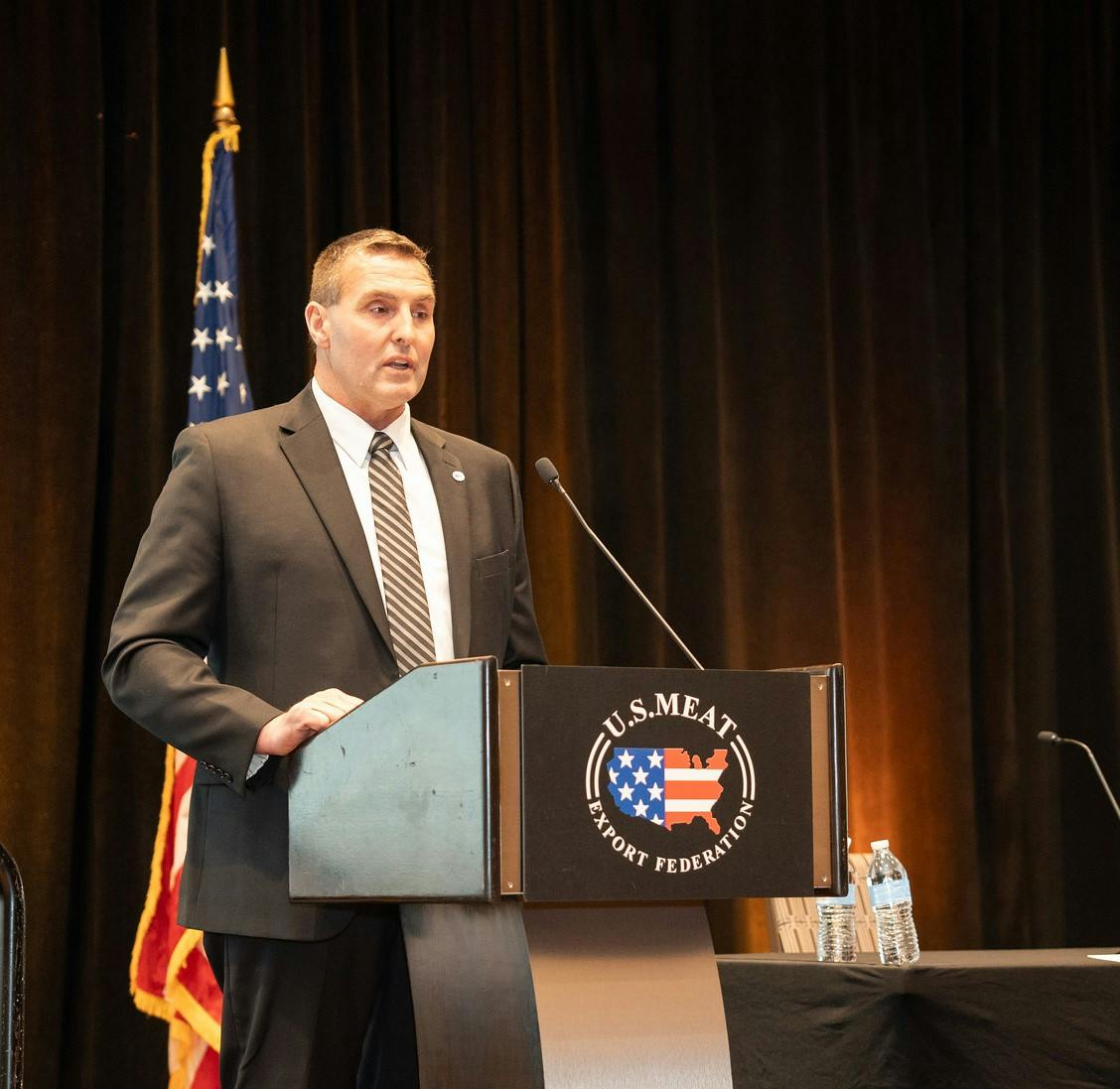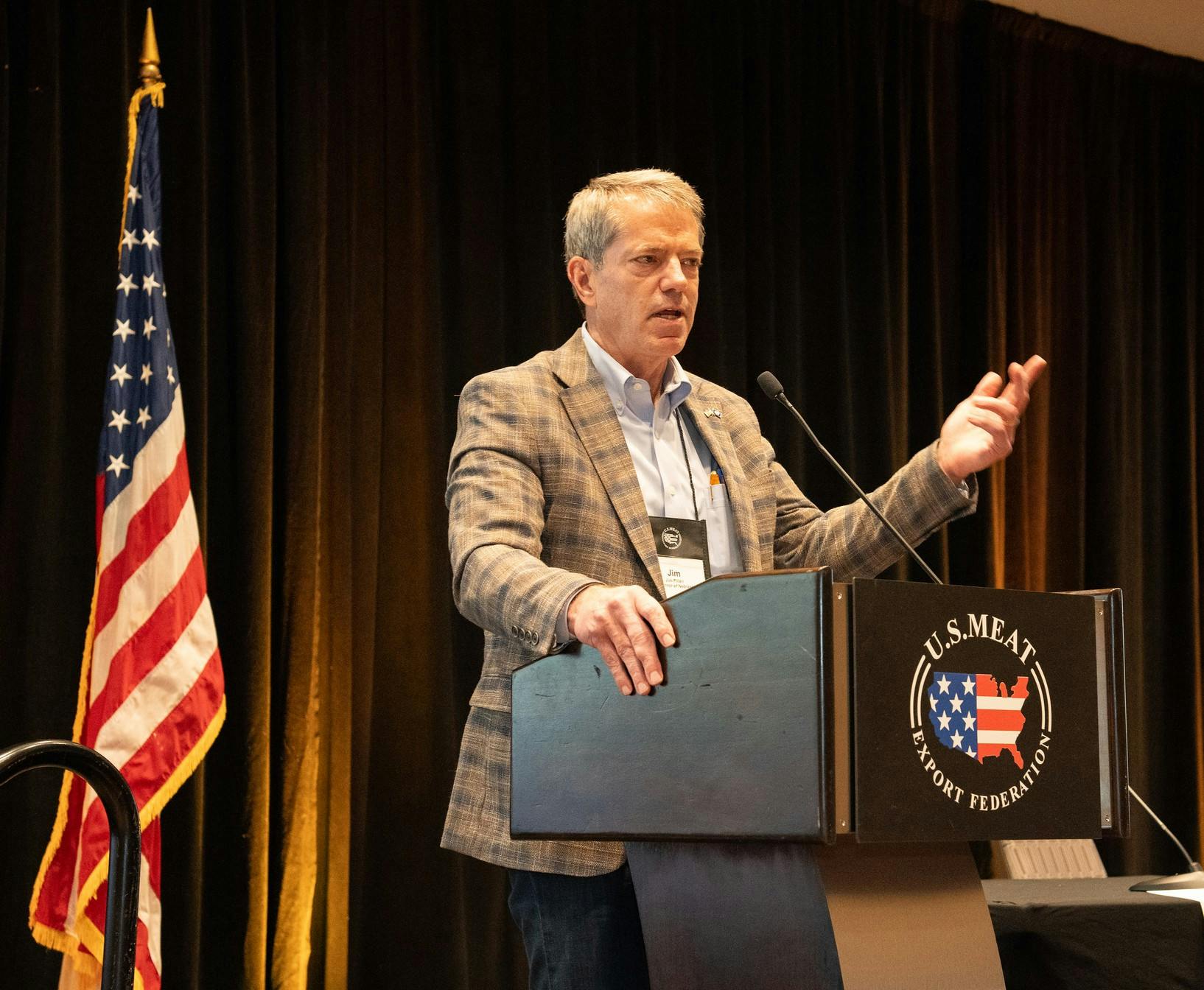USMEF Strategic Planning Conference Underway in New Orleans
The U.S. Meat Export Federation (USMEF) kicked off its Strategic Planning Conference Wednesday in New Orleans, covering a range of topics impacting global demand for U.S. pork, beef and lamb.
USMEF Chair Dean Meyer, a livestock and grain producer from Rock Rapids, Iowa, welcomed attendees with a reminder of how the organization brings together diverse sectors of agriculture to work toward common objectives.
“Regardless of the sector we are based in, we’re able to come together on most issues and provide a unified voice,” Meyer said. “And I don’t need to tell you, American agriculture needs that unified voice now more than ever, because there are critical programs and issues that need our support.”
Meyer highlighted the urgent need for progress crafting a new Farm Bill and reauthorizing agricultural appropriations, citing examples of programs critical to the U.S. meat and livestock industries. Protecting the U.S. livestock herd from foreign animal diseases is one such need, and Meyer drove this point home by noting that next month will mark the 20th anniversary of the first BSE case in the United States. This incident prompted most international markets to halt imports of U.S. beef, with some countries remaining closed for several years.


Keynote speaker Alexis Taylor, USDA under secretary for trade and foreign agricultural affairs, spoke about a new market development program recently announced by Agriculture Secretary Tom Vilsack. USDA plans to utilize $1.3 billion from the Commodity Credit Corporation to fund a Regional Agricultural Promotion Program (RAPP) aimed at diversifying export markets for U.S. agricultural products. While everyone is anxious to know the specifics of this new initiative, Taylor said USDA is “feverishly working” to finalize the details and will provide more information about the program soon – including how to apply for RAPP funds.
Taylor also spoke about USDA’s successful partnership with the red meat industry in expanding global demand. Noting the strong track record of USDA market development programs in providing value-added returns to U.S. producers, Taylor provided examples of how USMEF utilizes USDA funds to grow the international customer base. She also cited examples of USMEF member companies’ successful participation in USDA trade missions and USDA-endorsed trade shows. Taylor said the industry partnership also extends to market access, as USDA relies on USMEF’s in-market expertise to address trade barriers around the world.
Taylor also participated in a panel with USMEF staff to discuss how USMEF leverages industry investments in export markets. USMEF Senior Vice President of Industry Relations John Hinners kicked off this discussion by pointing to a recent Texas A&M study that found every dollar invested in USDA export market development programs returned an average of $24.50 to the industry. Hinners also highlighted a critical strategy that USMEF utilizes to leverage industry investments in export markets – third-party contributions. For many promotional activities that USMEF implements, importers, retailers and other industry partners make significant financial commitments, thereby extending the U.S. industry’s reach in key markets.
Jihae Yang, USMEF vice president for the Asia Pacific, emphasized the analytical approach USMEF uses to develop specific marketing strategies. Knowing where and how to invest is critical, she said, and working in-country enables USMEF staff to analyze individual markets, understand supply chains and build long-term relationships with businesses. Yang provided return-on-investment examples for specific promotions in which sales were calculated against USMEF’s investments, along with those of promotional partners.
USMEF Latin America Representative Homero Recio reviewed a USMEF training and evaluation program in Colombia that was developed to help butcher shops improve operational practices and, ultimately, increase sales of U.S. red meat. The butcher shop program, which was primarily developed for retail outlets owned by importers, improves food safety practices, customer service standards, product handling, packaging and merchandising. Recio shared investment and sales data for specific Colombian importers enrolled in the program, demonstrating the positive impact these operational improvements had on sales of U.S. pork and beef.


USMEF President and CEO Dan Halstrom also addressed conference attendees, providing an update on the current state of red meat exports and his outlook for 2024. Halstrom highlighted Mexico as a market in which both U.S. pork and beef are performing exceptionally well, with pork exports to Mexico well on the way to another annual record. He noted that U.S. pork exports are achieving broad-based growth in 2023, with demand accelerating in Central America and the Caribbean and the U.S. recapturing market share from European pork in several Asia Pacific destinations. The environment is less favorable for U.S. beef, with 2023 exports running well below last year’s record-large volumes in major Asian markets. But Halstrom emphasized that even in the face of significant headwinds, the U.S. beef industry has opportunities to capture new customers, especially by highlighting the value and versatility offered by underutilized beef cuts.
Guest speakers at the conference included ag policy journalist and analyst Jim Wiesemeyer, who provided an update on Farm Bill negotiations, the fast-approaching government shutdown deadline and other items of interest currently before Congress. Wiesemeyer also highlighted U.S. agricultural interests’ growing frustration over the lack of progress on some key trade issues, as well as the low priority placed on improving market access and exploring new trade agreements.
The conference’s opening day concluded with remarks from Nebraska Governor Jim Pillen. A veterinarian and pork producer by trade, Pillen recalled that early in his career, the United States was a net importer of pork. He expressed appreciation for USMEF’s efforts to expand global demand and to highlight the quality and safety of U.S. red meat.
“We have to work together to defend agriculture, grow agriculture, and sell it all over the world,” Pillen said. “And it’s important that we're very, very transparent, so that we can maintain the trust we’ve earned as the most respected producers in the world.”
Pillen also recapped his recent trade missions to Vietnam, South Korea and Japan, where he said it was a great privilege to represent Nebraska agriculture and promote U.S. products.

